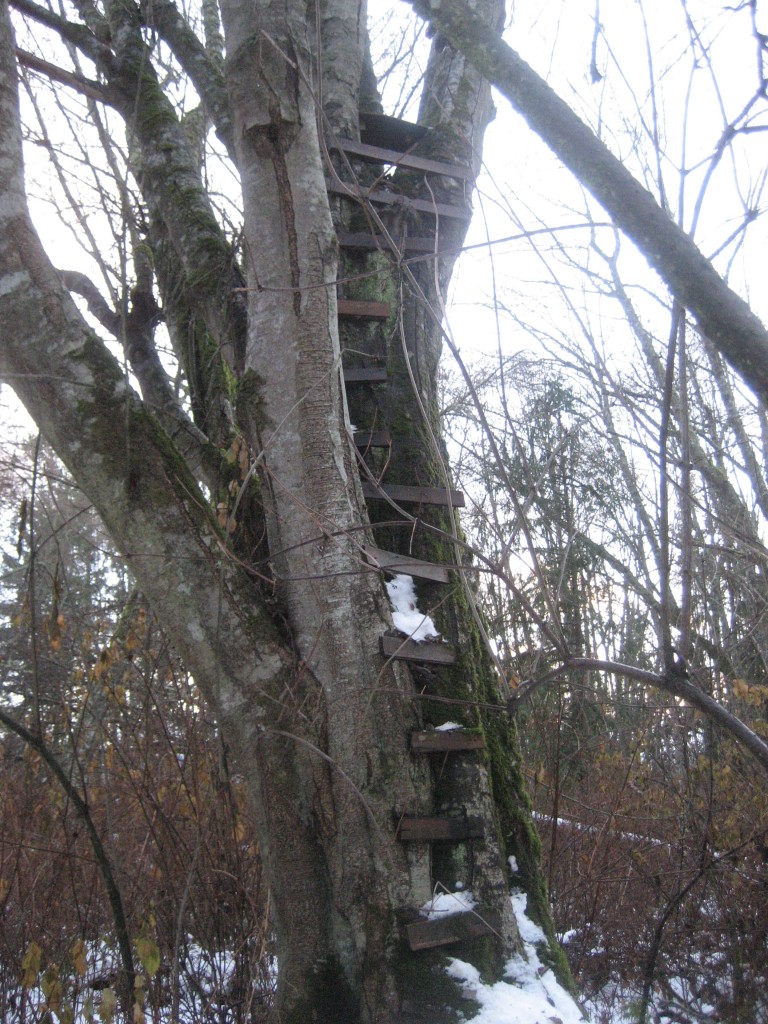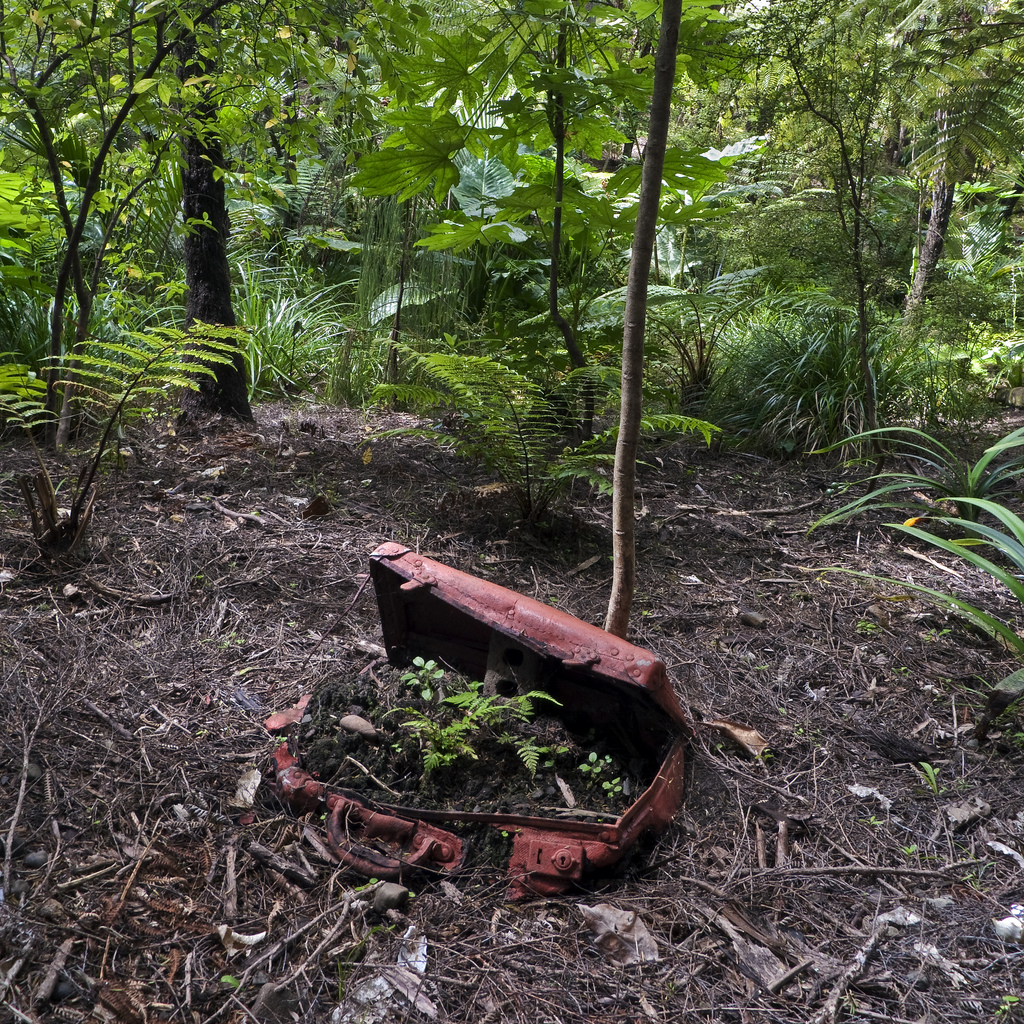 My friend Taya and I were out at her parents’ country place, about twelve acres in the western foothills of the Cascades. I was maybe eight, visiting for the first time. Taya was taking me on a tour. We were struggling along, as short-legged people do through dense, early successional Northwest forest. She stopped and took hold of a small sapling. “This,” she said, “is the difference between our land and a park.” And then, shockingly, she stepped on the sapling until it was bowed in two and then snapped it with her boot, killing it dead. Or maybe she ripped it out of the ground with her two hands—she was a very strong girl, I remember. I don’t remember the details of the act. But I do remember that she killed a tree and also the sensation of my mind being blown right out my ears. (Taya’s childhood arbor-cide didn’t presage sociopathy or anything close to it. She’s now a vet.)
My friend Taya and I were out at her parents’ country place, about twelve acres in the western foothills of the Cascades. I was maybe eight, visiting for the first time. Taya was taking me on a tour. We were struggling along, as short-legged people do through dense, early successional Northwest forest. She stopped and took hold of a small sapling. “This,” she said, “is the difference between our land and a park.” And then, shockingly, she stepped on the sapling until it was bowed in two and then snapped it with her boot, killing it dead. Or maybe she ripped it out of the ground with her two hands—she was a very strong girl, I remember. I don’t remember the details of the act. But I do remember that she killed a tree and also the sensation of my mind being blown right out my ears. (Taya’s childhood arbor-cide didn’t presage sociopathy or anything close to it. She’s now a vet.)
I was a city kid, so well schooled in the “leave no trace” ethos of wilderness preservation by school and camp that the idea of killing a tree…it wasn’t that it was wrong. It was that I had never even considered the possibility. Nature was, to me, inviolate, unchanging, ancient and pure. Pristine. It was better than God—less judgmental, more fun to play in, but just as serious and Big.
For a while, I went up with Taya and her parents almost every weekend—or so it seems to me now. And as we played in those woods, it ceased to be the Big Pristine to me. It became, instead, a familiar friend. Taya and I sought out springy tree limbs to use as bouncing seats, made expeditions to nearby notable rocks and built tiny worlds out of sticks and plants in the suggestive architectural spaces of rotting stumps. I particularly relished making trails. Taya’s dad lent me a pint-sized machete and taught me how to wield it.
I know now that the forest on the property was decidedly not old growth; it had been logged as recently as the 1950s. In amongst the slender alders, thorny salmon berries and sword ferns dusty with golden spores were massive stumps of giant cedars that had once grown there. I recall that some of them had notches in their great grey sides where the springboards had been fitted. I played, then, in a trash forest, a weedy place left behind after the good stuff was gone, no doubt rife with scotch broom and other invasive species.
 Ecologists and conservationists have long ignored such forests. In thrall to the lure of “pristine wilderness,” they shunned second growth. But that’s beginning to change. People like the UCLA’s Susanna Hecht and the Smithsonian’s Joe Wright have published work suggesting that secondary forests in the tropics are more like old growth than we used to think, that they have a surprising number of plant and animal species in them, and that they thus have pretty decent conservation value. (Though some other researchers think the value may be oversold due to the occasional appearance in secondary forest of a species that is mostly restricted to old growth.) Less work has been done in temperate forests, but the shift in thinking seems to be reaching all corners of the conservation world, and I think that’s an excellent thing. Not only are many secondary forests real steals when it comes to conservation bang for buck, but I hope that if the pros start valuing them, the rest of us will learn to value them too.
Ecologists and conservationists have long ignored such forests. In thrall to the lure of “pristine wilderness,” they shunned second growth. But that’s beginning to change. People like the UCLA’s Susanna Hecht and the Smithsonian’s Joe Wright have published work suggesting that secondary forests in the tropics are more like old growth than we used to think, that they have a surprising number of plant and animal species in them, and that they thus have pretty decent conservation value. (Though some other researchers think the value may be oversold due to the occasional appearance in secondary forest of a species that is mostly restricted to old growth.) Less work has been done in temperate forests, but the shift in thinking seems to be reaching all corners of the conservation world, and I think that’s an excellent thing. Not only are many secondary forests real steals when it comes to conservation bang for buck, but I hope that if the pros start valuing them, the rest of us will learn to value them too.
After half a dozen years reporting on conservation, mostly for Nature, I have learned that The Big Pristine doesn’t exist. Doesn’t now, didn’t ever. Around the world, prehistoric humans have had far greater impact on ecosystems than we ever knew. And climate change means that every place, old growth and trash alike, are now changed by humanity’s presence. Conservation approaches that move beyond fealty to the Big Pristine are starting to overtake older approaches centered on putting walls around protected areas and keeping hands off. More and more you hear talk of moving species to deal with climate change, or letting them move around without automatically freaking out about invasive species. More and more conservation projects are set in cities or on farms. I am by no means recommending large-scale killing of saplings by children as a conservation tool, but you never know. Nature has become less sacrosanct, and conservation is learning to become more interventionist. It is a bona fide paradigm shift, and it is fascinating to watch it happen. I’d like to think that the time I had as a child to pay such close attention to the vibrancy and beauty of that second dgrowth forest prepared me to document it.
My unscientific guess is that upwards of 80% of ecologists and conservationists first learned to love nature in places that weren’t pure, pristine or wild: culverts in cul de sacs, empty lots, summer camps on formerly logged land, hedgerows and the weedy margins of agricultural fields. We loved them as kids, and now we are learning to love them again as scientists and environmentalists. It is a kind of homecoming.
______________
Emma Marris is a freelance writer specializing in science and the environment. Her book on the future of conservation and the death of the Big Pristine is called Rambunctious Garden. It comes out on September 1st.
Photos:
“The nice thing about secondary forest is you can pound nails into it.” – Emma Marris
Suitcase forest – Ken McCown
I can’t believe this hasn’t drawn any comments yet. Really enjoyed the post, as well as the memories of my own childhood “trash forest” that it triggered. A few thoughts shared here:
http://markgchurchill.blogspot.com/2011/07/first-love-in-second-growth.html
Mark–I’ll add our science writer offspring to the 80% list (trash forest in suburban Atlana). Enjoyed your link as well.